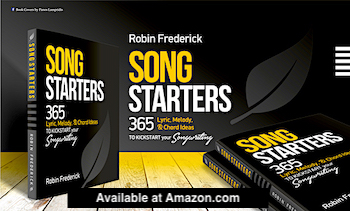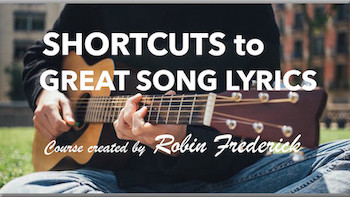I’d like to share a problem solving resource that seriously works for songwriters: Reference Tracks. These recordings can help you solve almost any problem and keep your songs and productions moving forward. If you’ve got a question, there’s a reference track that’s got the answer. If you’ve got a stream-on-demand music site like Spotify, Apple Music, or Amazon Music Unlimited, then all those answers are at your fingertips.
Studying and using a reference track doesn’t mean you’ll end up sounding exactly like that song. Reference tracks are tools. Use them as templates, teachers, and inspiration to support your own ideas and bring them to life.
FIND REFERENCE TRACKS FOR SONGWRITING
Start by finding successful songs you like in the genre you’re writing in (or a genre you’d like to write in). The quickest way to find recent hit songs sorted by genre is on the stream-on-demand sites like Spotify, Apple Music, and Amazon Music Unlimited. On Spotify and Amazon Prime Music (free with Prime), click in the SEARCH box for a list of genres. On Apple Music click on GENRES. Select a genre you’re interested in and look for current hits.
Make a list of the songs and artists in the top 15 spots. Go to your favorite stream-on-demand site and listen to at least the first minute of each song on your list. If you don’t like it, move on to the next one. Although you can learn from songs you don’t like, you’re going to be spending some time with the song you eventually choose, so why not pick one you enjoy?
If you don’t hear any songs on the charts you’re interested in, check out the big playlists on Spotify and Apple Music that highlight today’s top radio hits and some of the indie artists that are successful in the Film & TV market and college radio.
Use the Song Guides on this website to walk you through the hits.
Once you’ve identified a song or songs that interest you, it’s time to find out why, and how you could try something similar in a song of your own.
CHORD PROGRESSIONS
Many of today’s biggest hits are based on familiar three- and four-chord progressions that are not copyrighted. I’ve listed a few here. You can use reference tracks to help you learn how to use simple, repetitive chord progressions like these.
G, Amin, Emin, C – “Firework” (Katy Perry) and “Halo” (Beyonce)
F, G, Amin, Emin – “We Don’t Talk Anymore” (Charlie Puth)
D, Bmin, G, A – “Highway Don’t Care” (Tim McGraw)
Bmin, Emin, G, A – “Shape Of You” (Ed Sheeran)
ACQUIRE NEW CHORD & MELODY SKILLS. When you can comfortably play one of these chord progressions, get a feel for the way today’s melodies relate to them. Learn to sing and play one of the songs in the list above or a recent favorite of your own.
SONG STRUCTURE
FIND A STRUCTURE TEMPLATE. You can use a reference song to suggest the structure of a new song. Look at the structure of the reference song—verses, chorus, and bridge, etc. Make a note of each section in the order it appears in the song.
Use this basic structure as a template. Just write your verse where the verses are in the reference song, and your chorus where theirs is, and so on.
MAKE USE OF STRUCTURE DETAILS: If you like, you can follow the structure of the reference song in more detail. Does the song have a pre-chorus (a short section between the verse and chorus)? Does it have a catchy repeated vocal or instrumental hook at the end of the chorus, called a post-chorus? If so, try one in your own song.
How long is the intro? Make yours the same length. What happens at the end of the song? Is the whole chorus repeated or just part of it? Does it fade out or have a definitive ending? You do the same. If you’re wondering how long to make your verse or chorus, make them the same length as the reference song. You can change all of it it later if you want to, but it’s a place to start.
LYRICS
TURN ON THE CREATIVITY SWITCH. Sometimes it’s hard to get in the mood to write a lyric. You want to work on something but no really good lines are coming, not even any “not-half-bad” lines. That’s a good time to turn to your reference tracks.
Spend a few minutes listening to the lyrics of a song you like. Pay attention to the way a cliché is turned into something fresh, or how an emotion is described in images and actions, or how a word is used where you don’t expect it. Write a few lines that might work in that song. Turn off the music and keep writing. Eventually you can drop out all the lines from the original reference song.
Find out more about using images and actions in your lyrics.
FIND TIPS ON FOCUS AND DEVELOPMENT. Everyone knows it’s tough to come up with that second verse lyric. And the bridge! What will you say in your bridge? If you can’t think of anything to say next, go listen to a few of your reference tracks to see how they solved that problem.
Write a one-line summary of the information in the first verse and chorus. How did the second verse build on that, or change that? Did it tell the background story? Or talk about what the singer planned to do next? Or take us deeper into the singer’s feelings? What did the bridge reveal that we didn’t already know? Try that in your own song.
MELODY
GET INTO A MELODY MOOD. You can use reference songs to rev up your ideas for melody. Play a few successful songs you like. As you listen, notice how a good melody lifts the energy and drops it back down (dynamic change), defines the structure of the song (contrast between sections), and creates an expectation then breaks it (repetition with variation). Sing or play along with a successful song you like, then turn off the music and keep going on your own.
A rise in note range will add emotion, which is why choruses are usually in a higher note range than the verse. Short, repeated phrases add energy. These can be dropped into a pre-chorus to build anticipation leading up to a big chorus. Today’s hit songs often use a change of pace to give the chorus more punch. Let a few of your reference songs show you how it’s done in your genre.
LOOK FOR DYNAMIC CHANGE: Most songs have melodic arcs—a rise and fall of energy—from the verse to the chorus and back to the verse. Verse melodies tend to be more relaxed and conversational, while chorus melodies have more energy and emotion.
A rise in note range will add emotion, which is why choruses are usually in a higher note range than the verse. Short, repeated phrases add energy. These can be dropped into a pre-chorus to build anticipation leading up to a big chorus. Today’s hit songs often use a change of pace to give the chorus more punch. Let a few of your reference songs show you how it’s done in your genre.
WORK WITH REPETITION AND VARIATION. If you don’t have enough repetition in your melody, it will be hard to remember. If you have too much it will become predictable. So, how much melodic repetition do you need?
Listen to the melodies of successful songs in the style you want to write in and make a note of the number of times a melody line is repeated in a song section (with or without the same lyric). Then notice where it changes to something new and how often the new melody repeats. Does the first melody come back again? Look for a pattern of repetition and variation. Like this:
Melody Line A,
Repeat Line A with a new lyric.
Melody Line B
Repeat Line B with a new lyric.
You can hear this pattern in the chorus of Adele’s hit “Hello.” She sings the whole pattern once, then repeats it, and then ends with the word “anymore.” Listen for melody patterns in more hit songs and try using one in a song of your own.
REFERENCE TRACKS FOR ARRANGING
DIG INTO TODAY’S ARRANGEMENT STYLES. Now that home studios can turn out complete, broadcast quality recordings, songwriters are often arranging and playing not only the basic guitar or keyboard track, but drums, synthesizer, and even entire orchestral arrangements.
Listen to reference tracks in the style you’re working in to get creative ideas for building and developing your arrangements. What instruments are used? Where are instruments added or subtracted? Where does a fingerpicked guitar change to a strum?
UPDATE YOUR INSTRUMENT SOUNDS. Today’s electric guitar sounds are different from those that were popular in the ’70s and ’80s. Unless you are intentionally blending current and retro styles, you’ll want to update your electric guitar sound. The same goes for keyboard players. Study today’s piano sounds and synth pads. And if you just can’t stay away from your Farfisa, pair it with a current percussion track and bass for a fresh sound. (A little Farfisa goes a long way.)
REFERENCE TRACKS FOR MIXING
KEEP YOUR MIX IN PERSPECTIVE. You’ve been mixing that happy, upbeat track for ten hours now and it’s starting to sound dark and ominous instead of quirky and fun. So you brighten it up with a little EQ. Then you brighten it up some more, and a little more. Pretty soon it’s so piercing, only the neighborhood dogs can hear it. Stop. Listen to a reference track in the style you want. Let it remind your ears of what you started out to do. Adjust the EQ and move on. It will save you hours of time and a lot of hair pulling.
LEARN FROM PRO MIXES. Reference tracks won’t teach you how to use your equipment, at least not at first. But there are books, articles, YouTube videos, and online courses that can give you the knob-twiddling basics. Then turn to your reference tracks. Choose a sound you want to work on—deep background pads, Marshall-stack electric guitar, or biting, punchy drums—and try to recreate it on your own equipment.
So what are you waiting for? Grab a handful of your favorite tracks and get to work!


